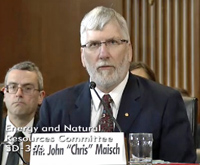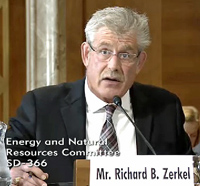(UPDATED November 19, 2015. Scroll down to see the updated information.)
****
Air tankers was one of the topics discussed today in a Washington D.C. hearing convened by the Senate Committee on Energy and Natural Resources. Richard B. Zerkel, President of Lynden Air Cargo, was one of six witnesses who testified, two of whom brought up issues about firefighting aircraft.
One of Mr. Zerkel’s main points in his prepared testimony was the “double standard” used by the U.S. Forest Service in managing their government owned air tankers and privately owned air tankers. The USFS will not operate the seven HC-130H air tankers obtained from the Coast Guard according to Federal Aviation Administration regulations as Part 121 air carrier aircraft, but will instead fly them as public use aircraft. This allows them to make up their own standards, or, as they announced, use procedures created by the Coast Guard who will advise the USFS about maintenance of the aircraft. (Fire Aviation wrote about this issue in September, 2015.)
Mr. Zerkel, in referring to the first of the USFS HC-130Hs which began spraying retardant on fires this summer, described it as “equipped with the obsolete MAFFS II dispersant system and operated without appropriate FAA oversight.” The MAFFS system uses compressed air to force the retardant out of the 3,000-gallon tank. Spraying the liquid, rather than allowing gravity to let it fall from the tank, breaks up the retardant into small droplets which does not penetrate tree canopies as well as a conventional gravity-powered system. The plans are to eventually replace the MAFFS tanks with conventional gravity systems, but the Air Force, the agency converting the aircraft into air tankers, has been dithering about the contracts for the retardant system since July of 2014, without any result so far.
Mr. Zerkel argued that the federal fire aviation fleet should operate their aircraft under the same standards they require of their contractors, FAA Part 121. The Chair of the Committee, Senator Lisa Murkowski from Alaska, the state in which Lynden Air Cargo is based, agreed, saying the current system “is absolutely unacceptable. You go with your highest standard.”
Lynden Air Cargo has skin in the game. The company took one of their seven L-382 cargo planes, a civilian version of the Hercules C-130, and spent $4.5 million, according to Mr. Zerkel, to retrofit it as an air tanker and train personnel to fly and maintain it. That aircraft is leased to Coulson who operates it as Air Tanker 132, currently on a firefighting contract in New South Wales, Australia. It was disqualified from competing for the USFS next-gen Version 2 air tanker contract earlier this year because part of the Supplemental Type Certificate had not been awarded from the Federal Aviation Administration by the USFS deadline, which was a couple of months before the contracts were awarded.
Mr. Zerkel said, “The commercial aerial firefighting industry is entirely capable of providing all of the Forest Service’s Large Air Tanker requirements at considerably less expense than the current planned use of C-130H aircraft.” And further, “The non-regulated, public aircraft format, proposed for the government owned large air tanker fleet is inherently less safe than the rigorous standards the commercial fleet must adhere to and has set an unfair double standard.
 Another witness from Alaska brought up the issue of inconsistent “carding”, or qualification of fire aviation assets. John “Chris” Maisch, the Alaska State Forester who was also representing the National Association of State Foresters, provided some examples of problems with “carding” individual pilots and aviation platforms.
Another witness from Alaska brought up the issue of inconsistent “carding”, or qualification of fire aviation assets. John “Chris” Maisch, the Alaska State Forester who was also representing the National Association of State Foresters, provided some examples of problems with “carding” individual pilots and aviation platforms.
- Colorado sent its multi-mission fire detection and mapping aircraft, which was approved by the Forest Service in its Region 2, to Oregon where it had to be carded again by Forest Service Region 6.
- A state of Alaska contract helicopter based out of California had been carded at the beginning of the fire season by the Forest Service and had to be re-carded by the Department of Interior’s Office of Aircraft Services when it reported to Alaska for work.
The video recording of the hearing can be viewed at the Committee’s web site.
****
UPDATE: On November 19, 2015 we heard from Richard B. Zerkel, President of Lynden Air Cargo, who testified at the hearing. He wanted to make it clear that he does not recommend that the U.S. Forest Service operate their air tankers under CFR Part 121. But he would like to see them under CFR Part 137 Agricultural Aircraft Operations that covers aerial dispensing. Failing that, Mr. Zerkel thinks they should at least be required to obtain Supplemental Type Certificates for all modifications and document any maintenance and or operational training which should then be available to the general public.


137 is merely a minimum operating certificate. It’s the combination of the airframe certification (how it was designed – for what purpose) and the maintenance standard (sustaining the airworthiness for the original design) that it is important. By focusing on FAA programs / processes for the contractors but exempting themselves from this same standard where it is convenient, the government (FS) has made the competition aspect unfair – I think this is part of what the testimony is about. It runs afoul of the government getting equipment to do things that are not carved out for government. This job can better be done by industry if the FS can articulate what they require. Since the leaders in DC were unable to do so for so many years, there was no clear path for industry to give the government what they wanted. Now that information is out there, the Feds need to get out of providing their own air tankers – which will be two or three times the cost of industry. I hope Bill is able to follow the money and cost for these seven aircraft, not only in the conversion but also the cost to operate. The current C130 operator is an easy comparison and has a superior delivery design. If the government is going to operate C130s why won’t the FS just install this exceptional system? Because of arrogance and that will cost the taxpayer significantly!
Today we added this to the article:
On November 19, 2015 we heard from Richard B. Zerkel, President of Lynden Air Cargo, who testified at the hearing. He wanted to make it clear that he does not recommend that the U.S. Forest Service operate their air tankers under CFR Part 121. But he would like to see them under CFR Part 137 Agricultural Aircraft Operations that covers aerial dispensing. Failing that, Mr. Zerkel thinks they should at least be required to obtain Supplemental Type Certificates for all modifications and document maintenance and operational training which should then be available to the general public.
Part 137 … probably a bad idea … air carrier and cargo aircraft operating outside of their design environment is already a concern. Part 137 doesn’t fix the problem.
see:
http://www.ntsb.gov/safety/safety-studies/Documents/SIR1401.pdf
“(NTSB) review of 78 accidents that occurred during calendar year 2013 and involved some aspect of agricultural (ag) operations, pilot training, or other crop protection activities. The report identifies the following recurring safety issues: lack of ag operations-specific fatigue management guidance, lack of ag operations-specific risk management guidance, inadequate aircraft maintenance…”
You’re right Leo. They define when an aircraft can be operated as a public service aircraft.
Public service means the certificate holder defines the maintenance program. Part 121 means the FAA defines the maintenance program and somewhere in the mix the operational loads monitoring program fits in because many of the aircraft are flying in an environment they weren’t designed for. Why not have an FAR to cover the mission for everyone and clean up the program?
Refer to FAA AC 00-1.1A dated 12 Feb 2014
Title 14 and Title 49 USC 40102(a)41 and 40125
Congress needs to address the problem, not the symptoms.
FAR part 121 covers the operations of commercial cargo and passenger aircraft flying routine flights they were designed for. It does not cover commercial aircraft flying in environments they were not designed for. There is no adequate FAR for air tanker operations.
What is required is an FAR that eliminates the excuse to operate air tankers and other firefighting aircraft as “public service” aircraft.
Yes, and if the USFS and Cal Fire had allowed a ‘demo’ drop to Evergreen’s 947 (as it had previously & like the 10-Tanker) as it did its STC in Long Beach, the 2006 Day Fire might not have reached my valley, eh Bob M.?
Let’s please stay on topic… the Senate hearing and the issues brought up therein.